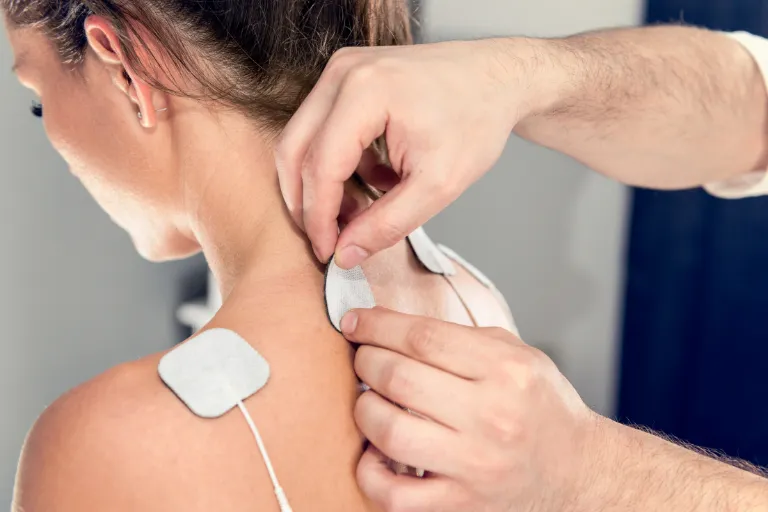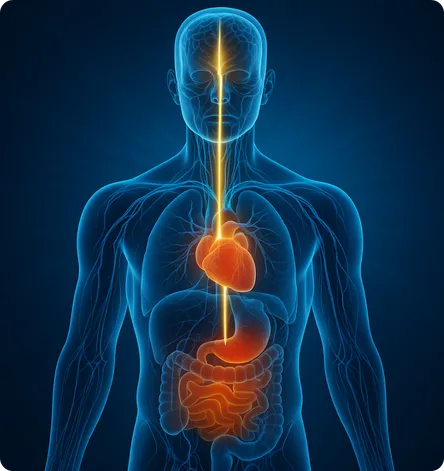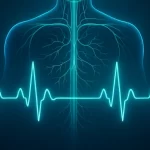TENS wurde entwickelt, um Muskeln anzusprechen — aber Ihr Vagusnerv erfordert einen anderen Ansatz. Entdecken Sie, warum sich die Ohrstimulation, die in 50+ klinischen Studien validiert wurde, als sicherste und wirksamste Möglichkeit zur Unterstützung des Gleichgewichts des Nervensystems herausstellt.

Warum TENS nicht dasselbe ist wie die Stimulation des Nervensystems
Wenn Sie schon einmal unter Rückenverspannungen oder Muskelkater gelitten haben, sind Sie möglicherweise auf Folgendes gestoßen: TENS-Geräte — Maschinen, die elektrische Impulse durch Klebepads auf der Haut abgeben.
TENS (Transkutane elektrische Nervenstimulation) wurde vor Jahrzehnten entwickelt, um Muskelbedingte Beschwerden vorübergehend lindern. Durch das Senden starker Impulse an sensorische Nerven kann es dazu beitragen, den Körper von Schmerzsignalen abzulenken.
Zu diesem Zweck funktioniert TENS gut.
Aber hier liegt das Missverständnis: TENS ist keine Vagusnervstimulation.
- Es verwendet höhere Ströme, die für Muskelfasern — nicht für das Nervensystem konzipiert sind.
- Es wird auf dem Rücken, den Schultern oder den Beinen angewendet — nicht an den am besten zugänglichen Punkten des Vagusnervs.
- Es wurde nicht klinisch auf Stressgleichgewicht, Erholung oder Vagustonus getestet.
Der Versuch, TENS für das Nervensystem zu verwenden, ist, als würde man ein Smartphone mit einem Hammer reparieren — das Tool passt nicht zum Job.

Lernen Sie den Vagusnerv kennen: den verborgenen Kontrollweg Ihres Körpers
Der Vagusnerv ist eines der wichtigsten —und übersehenen — Systeme im Körper.
- es ist das längster Hirnnerv, verläuft vom Hirnstamm nach unten durch Brust und Bauch.
- Es verbindet das Gehirn mit fast allen wichtigen Organen: Herz, Lunge, Verdauungstrakt, Immungewebe.
- Es überträgt Signale in beiden Richtungen:
- Efferent (Gehirn → Körper): Verlangsamung der Herzfrequenz, Beruhigung der Atmung, Aktivierung der Verdauung.
- Afferent (Körper → Gehirn): Senden von Updates zum Organstatus, zur Darmchemie und zur Immunfunktion zurück an das Gehirn.
Dieser wechselseitige Fluss macht es zum Kommunikationsautobahn des Körpers — Regulierung von Stressreaktionen, Erholung und innerem Gleichgewicht.
Wenn der Vagusnerv aktiv und gesund ist, wechselt Ihr Körper leicht zwischen “Kampf oder Flucht” und “Ruhe und Erholung.”
Wenn es unteraktiv ist, bleibt Ihr Körper im Stressmodus stecken — selbst wenn Sie sicher sind, gefüttert sind und versuchen, sich auszuruhen.
Warum der Vagustonus wichtig ist
Wissenschaftler verwenden den Begriff Vagustonus um zu beschreiben, wie gut der Vagusnerv funktioniert. Betrachten Sie es als “Fitness des Nervensystems.”
- Hoher Vagustonus ist mit einer höheren Herzfrequenzvariabilität (HRV) verbunden — ein Zeichen dafür, dass sich Ihr Körper an Stress anpassen und schnell wieder auf die Beine kommen kann.
- Niedriger Vagustonus ist mit einer niedrigeren HRV verbunden — tritt häufig bei Menschen auf, die mit Stress, Müdigkeit, Schlafproblemen und Genesungsproblemen zu kämpfen haben.
Untersuchungen zeigen, dass eine niedrige HRV mit einer Reihe von Gesundheitsproblemen korreliert, darunter Herz-Kreislauf-Belastung, Stimmungsungleichgewichte, Verdauungsbeschwerden und chronische Stress.
HRV: Der Anzeiger des Nervensystems
Die meisten Wearables können heute messen Herzfrequenzvariabilität (HRV) — die winzige Variation zwischen den einzelnen Herzschlägen.
- Hohe HRV Bedeutet, dass Ihr Körper flexibel ist: Sie können reibungslos von der Anstrengung zur Ruhe wechseln.
- Niedrige HRV bedeutet, dass Ihr Körper “im Gang feststeckt”: Stresssysteme bleiben aktiv, auch wenn Sie versuchen, sich zu entspannen.
Deshalb wird HRV zunehmend als “Stress-Score” des Körpers. Es spiegelt Ihre Widerstandsfähigkeit in Echtzeit wider.
Und wichtig: HRV ist nicht festgelegt. Es kann sich verbessern —, aber nur, wenn der Vagusnerv neu trainiert wird, um effektiver reagieren zu können.
Warum das Nervensystem mehr als TENS benötigt
TENS kann Muskeln zucken lassen. Der Vagusnerv braucht etwas anderes: TENS can cause muscles to twitch. The vagus nerve needs something else:
hier ist warum:
- Intensität: TENS-Geräte liefern Ströme im Bereich von mehreren zehn Milliampere und sollen Muskelfasern aktivieren. Der Vagusnerv reagiert auf Mikroströme — tausendmal sanfter.
- Einstufung: TENS-Pads sitzen auf Muskeln (Schultern, Rücken, Beine). Der Vagusnerv ist am besten zugänglich an der Ohr, wo sein Ohrast nahe der Haut verläuft.
- Ergebnisse: TENS führt Studien zur kurzfristigen Schmerzlinderung durch. Es liegen keine validierten Studien vor, die HRV-Verbesserungen, parasympathische Aktivierung oder Stressregulierung zeigen.
- Sicherheit: Die Verwendung von TENS in der Nähe des Halses oder der Brust, um den Vagus “zu erreichen”, kann riskant sein, da der Nerv in der Nähe empfindlicher Arterien und Venen verläuft. Eine fehlgeleitete oder übermäßige Stimulation birgt hier das ernsthafte Risiko einer Störung des Herzrhythmus — im Extremfall kann dies sogar zum Stillstand des Herzens führen.
Im Gegensatz zu zertifizierten Neuromodulationsgeräten sind die meisten TENS-Geräte nicht für die Verwendung im Vagusnerv konzipiert oder reguliert. Ihre Produktion kann unvorhersehbar ansteigen. Wenn die Intensität zu hoch ansteigt, besteht das Risiko irreversibler Nervenschäden, die zu langfristigen Komplikationen führen können, wie zum Beispiel:
- anhaltender Müdigkeit
- Chronische Verdauungsstörungen
- Verlust des autonomen Gleichgewichts (ähnlich dem, was Patienten nach einer chirurgischen Vagusnervschädigung erleben)
Aus diesem Grund warnen Experten: Versuchen Sie niemals, den Vagusnerv mit unregulierten TENS-Geräten “zu hacken”.
Aus diesem Grund empfehlen Forscher nicht, TENS für die Arbeit am Nervensystem umzuwidmen.

Der Aufstieg des taVNS: Transkutane Vagusnervstimulation
Um die Aktivität des Vagusnervs sicher zu unterstützen, entwickelten Wissenschaftler taVNS (transkutane Stimulation des Nervus auricularis vagus).
Anstelle chirurgischer Implantate (die ursprüngliche VNS-Methode) verwendet taVNS einen kleinen Ohrclip, der liefert Niedrigstufige, klinisch kalibrierte Mikroströme Direkt zum Ohrast des Vagusnervs.
Dieser Ansatz ist:
- Non-invasiv: Keine Operation, keine Implantate
- Präzise: Ziel ist der Ast des Vagusnervs, der am Ohr am besten zugänglich ist
- validiert: In kontrollierten klinischen Studien untersucht
- Praktisch: kann zu Hause beim Lesen, Arbeiten oder Entspannen verwendet werden
sieh es als Physiotherapie für den Vagusnerv. So wie Sie Muskeln trainieren können, um stärker zu werden, hilft taVNS dem Vagusnerv, seine Flexibilität wiederzuerlangen.
Was Forschung zeigt
Aurikuläres taVNS wurde in Dutzenden von von Experten begutachteten Studien und Übersichtsarbeiten untersucht:
- Parasympathische Aktivierung: In einer kontrollierten Studie stellten die Teilnehmer im Vergleich zu Placebo eine Steigerung der parasympathischen Aktivität um bis zu 61 % fest.
- HRV-Verbesserungen: Mehrere Studien berichten von Aufwärtstrends bei der Herzfrequenzvariabilität bei konsequenter Anwendung.
- Symptomuntersuchung: Die Forschung hat taVNS auf seinen potenziellen Einfluss auf Schlafqualität, Stimmungsregulation, Verdauungskomfort und Stressresistenz untersucht — wobei die Teilnehmer ermutigende Ergebnisse berichteten.
- Sicherheit: In Millionen von Sitzungen wurden keine schwerwiegenden unerwünschten Ereignisse gemeldet. Die häufigste Nebenwirkung ist eine vorübergehende lokale Reizung am Ohr.
- Unabhängige Validierung: Eine von Experten begutachtete Studie aus dem Jahr 2024 (DOI: 10.5281/zenodo.17042945) kam zu dem Schluss, dass die Stimulation der Ohrmuschel der sicherste und selektivste nicht-invasive Weg zur Aktivierung des Vagusnervs ist.
Diese Forschungsbasis ist der Grund, warum taVNS als Eckpfeiler von gilt Bioelektronische Gesundheitstechnologie
Warum Bildung wichtig ist, bevor Sie sich für ein Gerät entscheiden
An dieser Stelle fragen Sie sich vielleicht: “Wenn taVNS validiert ist, warum sind dann so viele Gadgets auf dem Markt?”
Die Antwort: Nicht alle Geräte folgen der Wissenschaft.
Warnsignale, die Sie vermeiden sollten:
- Unklare Stimulationsstelle: Wenn es nicht am Ohr ist, zielt es wahrscheinlich nicht auf den Vagus ab.
- Signale hoher Intensität: Entwickelt für Muskeln, nicht für Nerven.
- Keine klinischen Studien: Marketingaussagen ohne von Experten begutachtete Validierung.
- Keine Sicherheitsdaten: Keine Sicherheitsdaten:
Wenn es um das Nervensystem geht, sind Präzision und Validierung nicht optional — sie sind unerlässlich.

Aurikuläres tVNS klinischen Grades: Das Nurosym-Gerät
Die nicht-invasive Vagusnervstimulation (tVNS) hat in Forschung und klinischer Praxis zunehmend an Aufmerksamkeit gewonnen, da sie eine Möglichkeit zur Beeinflussung der autonomen Regulation darstellt. Zu den für diesen Zweck entwickelten Geräten gehören Nurosym ist eine CE-gekennzeichnete Option, die für den Heimgebrauch entwickelt wurde. Es wendet eine kalibrierte elektrische Mikrostimulation auf den Ohrast des Vagusnervs an — die spezifische Stelle, die in klinischen Untersuchungen am häufigsten untersucht wird.
Regulatorischer und klinischer Kontext
- Zertifiziert: Nurosym hat erhalten CE-Kennzeichnung in Europa, was die Konformität mit Sicherheits- und Leistungsstandards für Medizinprodukte anzeigt.
- validiert: Aurikuläres tVNS wurde untersucht in Über 50 veröffentlichte Studien, von Pilotstudien bis hin zu randomisierten kontrollierten Untersuchungen. In diesen Studien wurden Ergebnisse wie Herzfrequenzvariabilität (HRV), Entzündungssignale, Müdigkeit, Schlafqualität und stressbedingte Symptome untersucht.
- Vertraut: Geräte dieser Art wurden sowohl in Forschungsprotokolle als auch in die klinische Praxis integriert. Berichten zufolge wird es von Klinikern übernommen, die an autonomer Regulierung interessiert sind, die Integration in die gängigen Richtlinien befindet sich jedoch noch in der Entwicklung.
- Sicherheitsbilanz: In der veröffentlichten Literatur wurde aurikuläres tVNS im Allgemeinen gut vertragen. Der häufigste Bericht ist ein leichtes Kribbeln oder eine leichte Wärme an der Stimulationsstelle. Bisher wurden in klinischen Studien keine schwerwiegenden Nebenwirkungen auf ordnungsgemäß verabreichtes aurikuläres tVNS zurückgeführt.
Berichtete Erfahrungen und Beobachtungen
Personen, die aurikuläres tVNS mit Geräten wie Nurosym getestet haben, beschreiben häufig eine Abfolge von Erfahrungen:
- Während der Sitzungen: Benutzer berichten häufig von einem leichten Kribbeln im Ohr, begleitet von einem subjektiven Gefühl der Ruhe. Dies steht im Einklang mit dem vorgeschlagenen Mechanismus der parasympathischen Aktivierung.
- Nach mehrwöchiger Anwendung: Einige Personen bemerken Verbesserungen in Schlafkontinuität, verminderte Wahrnehmung von Energieeinbrüche am Nachmittag und größere Stabilität der täglichen Routinen. Obwohl solche Berichte anekdotisch sind, stimmen sie mit Ergebnissen aus klein angelegten Studien überein, in denen HRV- und Schlafmetriken untersucht wurden.
- With longer-term use: HRV-Messungen zeigen in einigen Fällen Aufwärtstrends, was auf einen verbesserten Vagustonus schließen lässt. Einzelpersonen beschreiben häufig eine verbesserte Anpassungsfähigkeit an Stress, eine stabilere Konzentration und eine geringere Wahrnehmung täglicher Spannungen. Um diese Langzeiteffekte zu bestätigen, sind noch größere kontrollierte Studien erforderlich.
Unterscheidung zwischen aurikulärem tVNS und TENS
Es ist wichtig zu klären, wie sich aurikuläres tVNS von häufiger verfügbaren transkutanen elektrischen Nervenstimulationseinheiten (TENS) unterscheidet:
- Speziell gebaut: TENS-Geräte wurden ursprünglich zur Schmerzbehandlung entwickelt und stimulieren periphere Muskeln und Nerven. Im Gegensatz dazu sind tVNS-Geräte wie Nurosym speziell für den Vagusnerv kalibriert.
- Kalibrierte Ströme: TENS liefert typischerweise Ströme im Milliampere-Bereich, die stark genug sind, um Muskelfasern zu aktivieren und manchmal sichtbare Kontraktionen zu verursachen. Aurikuläres tVNS verwendet sanfte Mikroströme mit tausendmal geringerer Intensität, die für die Modulation neuronaler Bahnen ohne Muskelaktivierung geeignet sind.
- Validierte Site: Untersuchungen haben ergeben, dass Aurikulärer Ast des Vagusnervs — am Ohr zugänglich — als einzige nicht-invasive Stelle, an der die Stimulation zuverlässig in die Vagusbahnen eingreift. Andere Ansätze (z. B. das Anbringen von Elektroden in der Nähe des Halses) bergen möglicherweise das Risiko, benachbarte Strukturen wie die Halsschlagader oder die Halsvene zu stimulieren, was Sicherheitsbedenken mit sich bringt.
- Klinische Aufzeichnung: Über 50 von Experten begutachtete Veröffentlichungen haben sich mit aurikulärem tVNS befasst, darunter auch systematische Übersichtsarbeiten. Die Evidenzbasis für herkömmliches TENS umfasst keine validierten Auswirkungen auf die HRV oder das autonome Gleichgewicht.

Praktische Überlegungen für den täglichen Gebrauch
Nurosym und ähnliche Geräte sind so konzipiert, dass sie sich leicht in den Alltag integrieren lassen.
- Elektrodenplatzierung: Die Elektrode wird am Tragus des Ohrs befestigt. Im Gegensatz zu TENS-Pads Es ist kein leitfähiges Gel erforderlich, wodurch Unordnung reduziert und die Verwendung unterwegs bequemer wird.
- Komforteinstellung: Die Intensität ist einstellbar und die meisten Menschen beschreiben das Gefühl als ein leichtes Kribbeln, das zur Beruhigung titriert werden kann.
- Aktivität während der Sitzungen: Da die Stimulation lokal und störungsfrei erfolgt, können Einzelpersonen während der Verwendung des Geräts normalerweise lesen, planen oder sich entspannen.
- Typisches Protokoll: Viele Protokolle beinhalten 30 Minuten täglicher Gebrauch, wobei einige Personen eine zusätzliche Abendsitzung wählen, um Entspannung und Erholung zu unterstützen.
mögliche Ergebnisse
Obwohl die Antworten unterschiedlich sind, wurden die folgenden Ergebnisse sowohl in Benutzerberichten als auch in klinischen Forschungskontexten beschrieben:
- Morgenbereitschaft: Einige Personen berichten, dass sie leichter aufwachen und weniger auf Stimulanzien wie Koffein angewiesen sind.
- Stressreaktion: Tägliche Stressfaktoren können sich beherrschbarer anfühlen, was mit der Hypothese eines erhöhten Vagustonus übereinstimmt.
- Energiestabilität: Reduzierte Wahrnehmung der Mittagszeit “Unfälle” mit gleichmäßigerer Konzentration im Tagesverlauf.
- Abendliche Erholung: Ein natürlicheres Gefühl der Entspannung in der Nacht, manchmal begleitet von einer verbesserten Schlafqualität.
- Objektive Bestätigung: HRV-Tracking-Geräte zeigen bei konsequenter Nutzung häufig Aufwärtstrends, was auf eine verbesserte autonome Anpassungsfähigkeit zurückzuführen ist.
FAQ
Kann ich mein TENS-Gerät einfach zur Vagusstimulation verwenden?
Nein. TENS ist nicht für diesen Zweck konzipiert. Es verwendet höhere Ströme, zielt auf die Muskeln ab und es fehlt eine Validierung für die Ergebnisse des Nervensystems.
Ist Nurosym sicher?
Ja. Veröffentlichte Forschungsergebnisse zeigen, dass es in den bisherigen Studien keine schwerwiegenden Nebenwirkungen gab. Kleinere Auswirkungen wie lokale Ohrreizungen sind selten und vorübergehend.
Werde ich die Ergebnisse schnell spüren?
Manche Benutzer fühlen sich während der Sitzungen ruhiger. Messbare Veränderungen der HRV und Resilienz werden durch konsequente Nutzung aufgebaut.
Do I need to track HRV?
Es ist optional —, aber viele freuen sich, wenn Daten bestätigen, was sie fühlen.
Was ist, wenn es mir nicht passt?
Jedes Nurosym ist mit einer 30-tägigen Geld-zurück-Garantie ausgestattet.
der nächste Schritt
TENS wurde für Muskeln entwickelt. Ihr Nervensystem verdient Präzision.
Mit Nurosym können Sie zugreifen klinisch validierte Stimulation des Nervus vagus auricularis zu Hause — sicher, einfach und messbar.
Nicht umfunktionieren. Raten Sie nicht. Wählen Sie die für den Job konzipierte Methode.
Haftungsausschluss: Diese Seite dient nur zu Bildungszwecken. Es bietet keinen medizinischen Rat. Konsultieren Sie immer einen qualifizierten Arzt, bevor Sie mit neuen Therapien beginnen.
Bezüge:
- Butt, M. F., Albusoda, A., Farmer, A. D., & Aziz, Q. (2020). The anatomical basis for transcutaneous auricular vagus nerve stimulation. Journal of Anatomy, 236(4), 588–611. https://doi.org/10.1111/joa.13122
- Peuker, E. T., & Filler, T. J. (2002). The nerve supply of the human auricle. Clinical Anatomy, 15(1), 35–37. https://doi.org/10.1002/ca.1089
- Kreuzer, P. M., Landgrebe, M., Husser, O., Resch, M., Schecklmann, M., Geisreiter, F., … Langguth, B. (2012). Transcutaneous vagus nerve stimulation: Retrospective assessment of cardiac safety in a pilot study. Frontiers in Psychiatry, 3, 70. https://doi.org/10.3389/fpsyt.2012.00070
- Clancy, J. A., Mary, D. A., Witte, K. K., Greenwood, J. P., Deuchars, S. A., & Deuchars, J. (2014). Non-invasive vagus nerve stimulation in healthy humans reduces sympathetic nerve activity. Brain Stimulation, 7(6), 871–877. https://doi.org/10.1016/j.brs.2014.07.031
- Kim, A. Y., Marduy, A., de Melo, P. S., Gianlorenco, A. C., Kim, C. K., Choi, H., Song, J.-J., & Fregni, F. (2022). Safety of transcutaneous auricular vagus nerve stimulation (taVNS): A systematic review and meta-analysis. Scientific Reports, 12(1), 22055. https://doi.org/10.1038/s41598-022-25864-1
- Food and Drug Administration. (2019). Allgemeines Wohlbefinden: Richtlinie für Geräte mit geringem Risiko (Leitfaden für Industrie- und FDA-Mitarbeiter). Abgerufen von https://www.fda.gov/media/90652/download
Teilen über:


